Key takeaways:
- Culinary education encompasses not only recipes but also the cultural and historical context of food, fostering creativity and resilience in the kitchen.
- Historical cooking tools enhance our culinary skills, providing a deeper connection to tradition and inspiring creativity in cooking.
- Using traditional tools encourages patience and mindfulness, highlighting the significance of technique and the stories behind our cooking methods.
- Selecting and utilizing historical tools can transform cooking into a more meaningful and enjoyable experience, rooted in authenticity and simplicity.
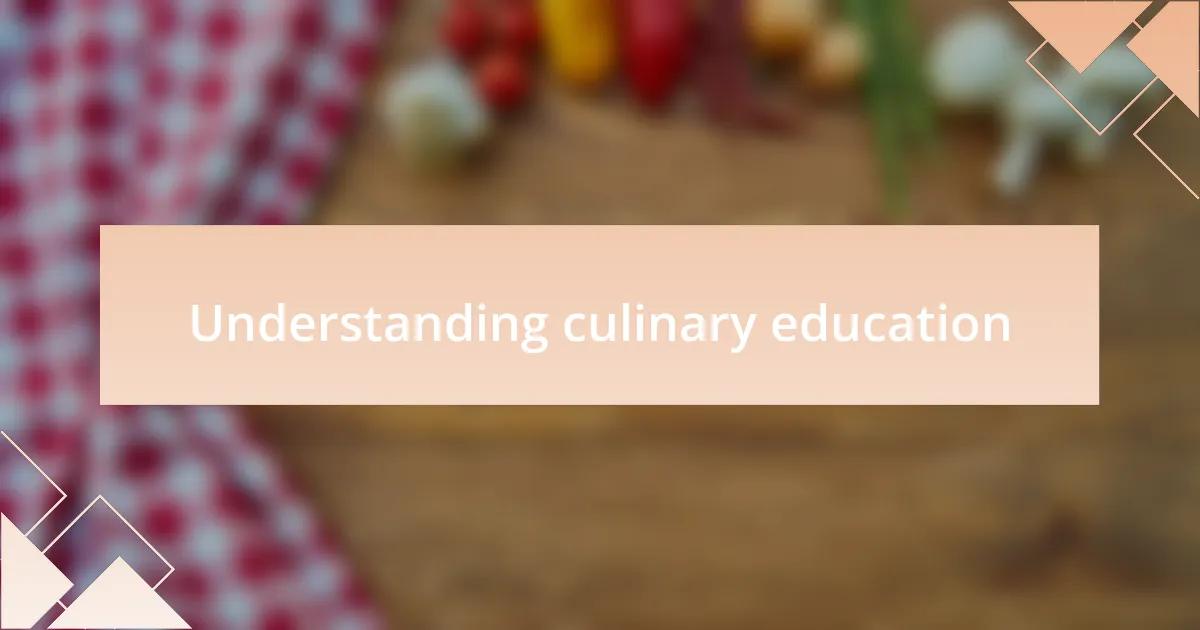
Understanding culinary education
Culinary education goes beyond just learning recipes; it’s about understanding the history, culture, and science behind food. I remember the first time I used a mortar and pestle—it felt like a rite of passage, connecting me to centuries of cooks before me. How does that historical context enrich our cooking today?
In my experience, culinary education fosters creativity, pushing us to experiment with different tools and techniques. I once attended a workshop where we delved into ancient cooking methods, and it opened my eyes to flavors I had never considered. Isn’t it fascinating how a simple tool can transform not only a dish but also our approach to cooking?
The journey of learning about food often involves moments of triumph and occasionally, some well-earned failures. I vividly recall trying to recreate a traditional bread recipe using a clay oven; the first few attempts were definitely a flop! Yet, each misstep taught me something valuable about patience and resilience in the kitchen. What lessons are waiting for you in your culinary exploration?
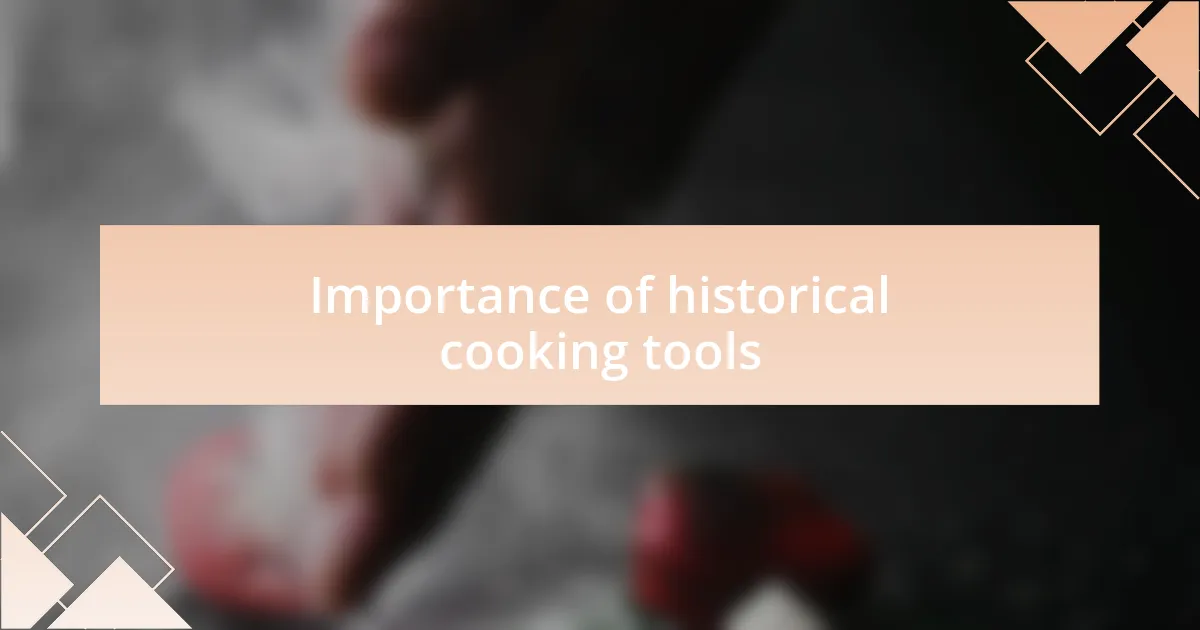
Importance of historical cooking tools
Understanding the importance of historical cooking tools opens a door to the past that enhances our culinary skills today. For instance, using a cast iron skillet transports me back to when home cooks relied on sturdy cookware to create hearty meals. How much richer is an omelet made in such a pan, steeped in tradition?
I find that historical tools not only offer practical benefits but also a deeper connection to our culinary heritage. While experimenting with a traditional French wooden spoon, I felt an unexpected intimacy as if I were stirring alongside generations of chefs. Isn’t it intriguing how a simple piece of wood can carry stories that enhance our cooking experience?
Moreover, engaging with these tools often sparks creativity in ways I didn’t anticipate. After attempting to use a handmade pasta board, I discovered how much more satisfying it was to create my favorite dish from scratch, connecting me to centuries of Italian pasta makers. Isn’t that sense of belonging to a larger tradition a delicious part of our culinary journey?
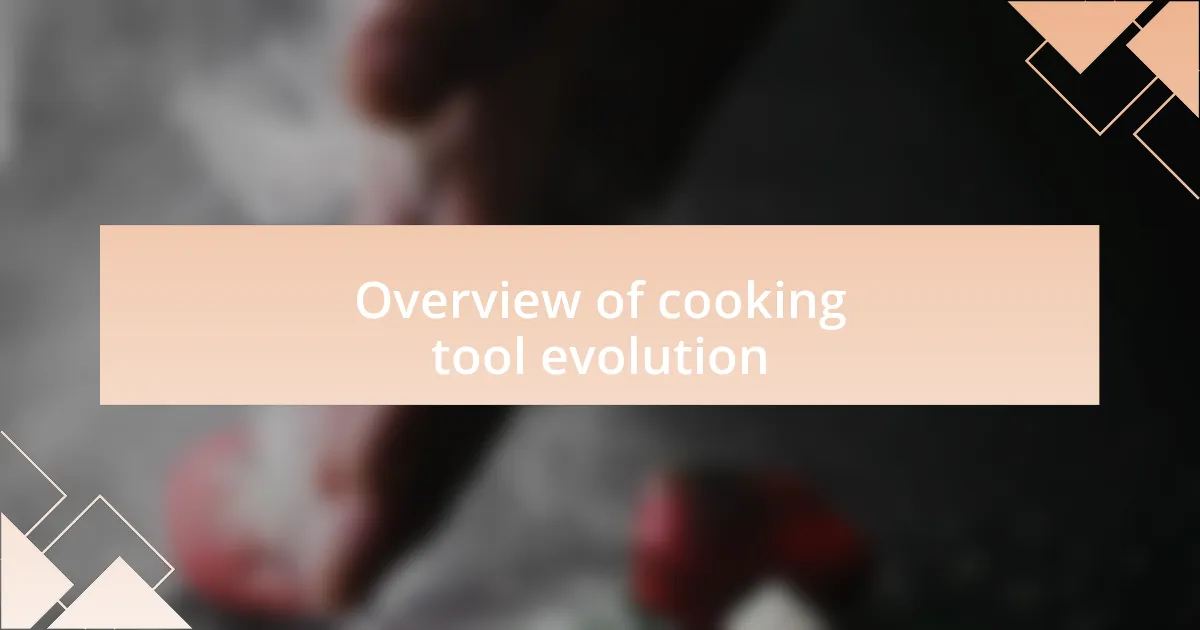
Overview of cooking tool evolution
Throughout history, cooking tools have evolved significantly, mirroring changes in society, technology, and culinary practices. For example, consider the humble mortar and pestle, a simple yet effective tool that dates back thousands of years. When I used one to grind fresh spices, the fragrant aromas filled the air, reminding me of how these ancient techniques still resonate in modern kitchens.
As time progressed, so did the materials and designs of cooking tools. The transition from clay pots to modern stainless steel cookware reflects not just advances in materials science but also shifts in our dining habits. I remember the first time I cooked with a modern non-stick frying pan; it was a revelation! It made me think: how many generations of cooks wished for such ease of cleanup?
In recent years, there’s been a resurgence of interest in vintage and artisanal cooking tools. This revival is more than just a trend; it’s a collective yearning for authenticity and connection. It struck me while preparing a meal with a vintage hand-cranked egg beater that sometimes the simplest tools provide the most joy. Isn’t it fascinating how these relics of our culinary past can inspire a new appreciation for the food we create today?
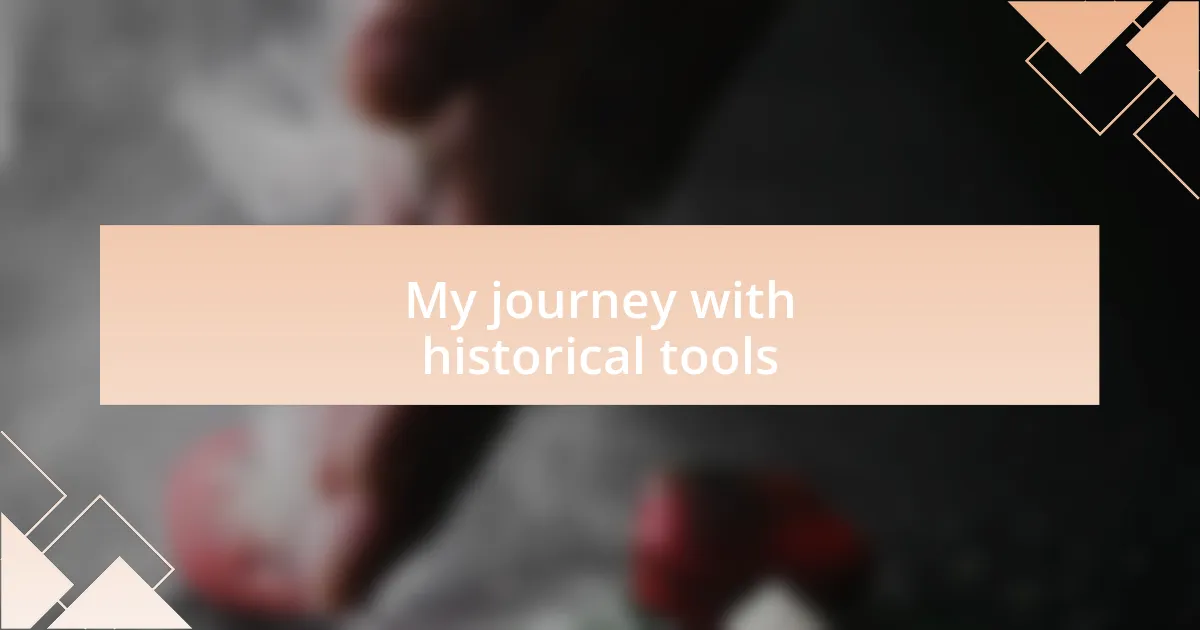
My journey with historical tools
My exploration of historical cooking tools has been a delightful adventure, filled with unexpected moments of discovery. I vividly recall the first time I used a cast-iron skillet, its weighty presence grounding me in centuries of tradition. As I cooked, I couldn’t help but wonder about the countless meals crafted in similar pans, connecting me to a lineage of cooks who knew the importance of imparting depth of flavor.
Taking on the challenge of using a wooden spoon instead of modern utensils was another eye-opening experience. At first, I struggled to find an efficient rhythm, but slowly, I began to appreciate the tactile connection it provided. Each stir was deliberate and intentional, reminding me of the care our ancestors took with their meals. How often do we overlook such simple pleasures in the hustle of modern cooking?
While experimenting with a hand-cranked butter churn, the process felt both nostalgic and meditative. As I cranked the handle, watching cream transform into rich, creamy butter, a wave of satisfaction washed over me. This hands-on interaction made me ponder: in an age of convenience, what do we lose when we sidestep these hands-on experiences with food? These moments have deepened my appreciation for the artistry of cooking and the tools that define it.
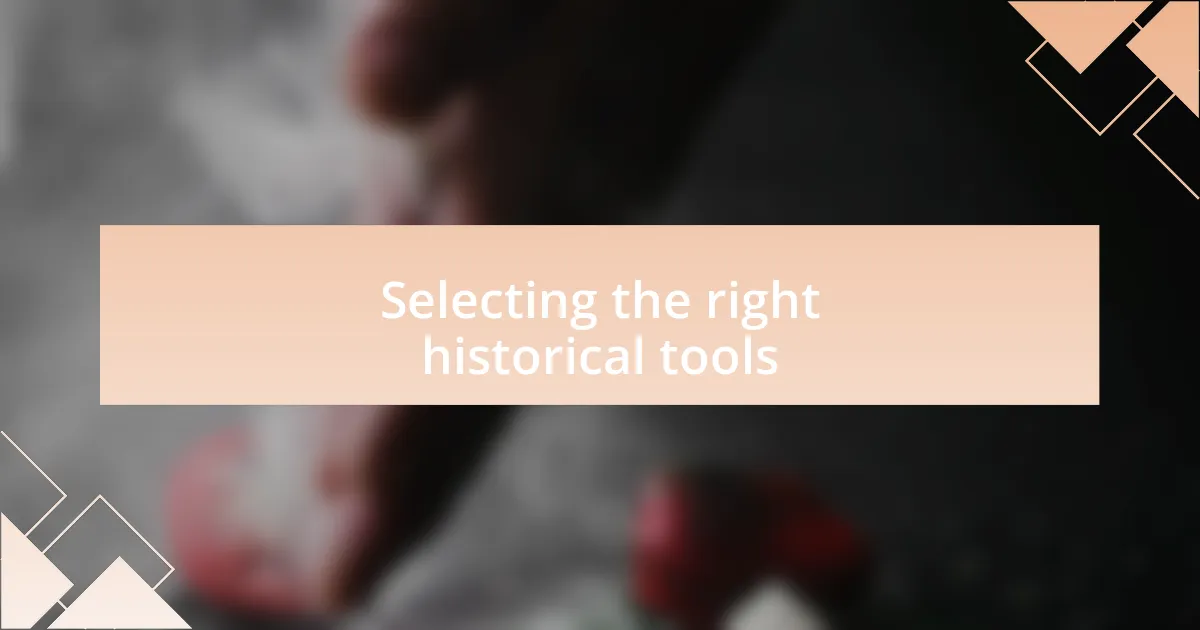
Selecting the right historical tools
Selecting the right historical tools can feel daunting, given the sheer variety available. I remember standing in an antique shop, grappling with the decision to choose between a pewter measure and a clay jug for my baking experiments. Ultimately, I went with the clay jug, drawn to its rustic charm and the thought of how bakers in past centuries must have relied on similar vessels.
When it comes to tools like rolling pins, the choice matters greatly. I initially tried a modern one but found myself reaching for a beautifully worn, wooden pin I picked up at a flea market. The weight and texture spoke to me, and suddenly rolling out dough became less of a chore and more of an enjoyable ritual. I often ask myself: how many moments like this have I missed by sticking to contemporary tools?
Next, I discovered the charm of hearth utensils for aspects of cooking that I had never considered before. Using a basic iron spatula felt like wielding a piece of history, evoking a deep sense of craftsmanship. The connection I forged with this simple tool made me realize—do I really need complexity in my kitchen, or is the essence of cooking found in simplicity and authenticity? Each time I use it, I’m reminded of the joy that comes from a thoughtful selection of tools.
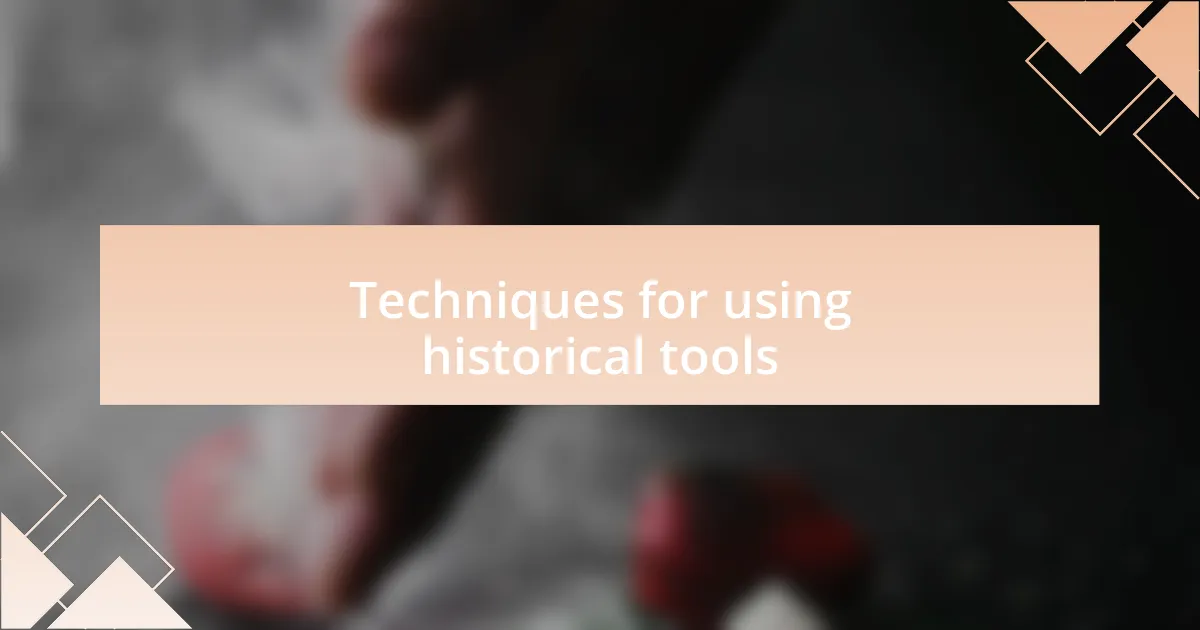
Techniques for using historical tools
Using historical tools requires understanding their unique qualities and how to leverage them effectively. For example, when I first tried a stone mortar and pestle, I was surprised by the effort it required compared to modern appliances. However, with each grind, I felt a connection to past generations, as if their culinary spirit was guiding me to extract the purest flavors from herbs and spices.
I found that patience is essential when using these tools. The first time I made bread using a wooden bowl and a primitive whisk, I underestimated the time needed to achieve a good dough consistency. The rhythmic motion of mixing by hand became almost meditative, reminding me that cooking is as much about the process as it is about the end result. Have you ever taken the time to savor the rhythm of your cooking?
Moreover, getting accustomed to the nuances of these tools can really enhance the experience. One evening, I decided to experience the slow simmer of a stew in a Dutch oven over an open flame. The nostalgia it stirred as I watched the golden flames lapping at the edges reminded me that cooking has always been a communal activity. There’s something magical about using a tool that’s steeped in history—it’s like joining a culinary conversation that spans centuries. What stories could your own cooking tools tell?
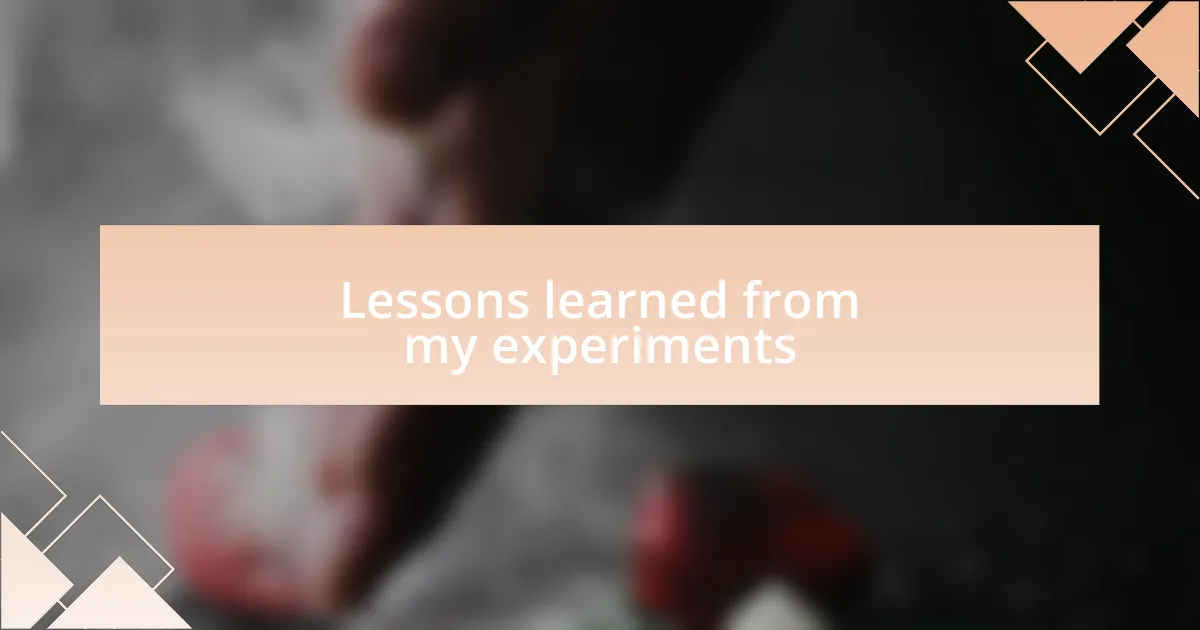
Lessons learned from my experiments
Experimenting with historical cooking tools revealed the intricacies of culinary patience. When I used a clay pot for the first time, I was met with the challenge of achieving the right temperature. Each minute felt like an eternity, but as the aromas began to evolve, I realized the beauty of waiting. Have you ever felt that thrill when something delicious starts to come together, even if it takes longer than expected?
Another significant lesson was the importance of technique. I remember my initial attempts at using a hand-cranked butter churn. It was a workout for my arms, but with every turn, I could sense the rich, creamy transformation happening right before my eyes. This process taught me that the physicality involved can deepen my appreciation for the food. How often do we overlook the efforts that go into our meals?
Finally, utilizing these tools reminded me of the stories behind our food. While mixing ingredients with a handmade wooden spoon, I often pondered who had crafted it. Each scratch and smooth edge told a tale, reminding me that cooking is not only about nourishment but also about heritage. Have you ever thought about the last time you connected with the history of your cooking tools? It’s a powerful reminder that every meal is part of a larger narrative.